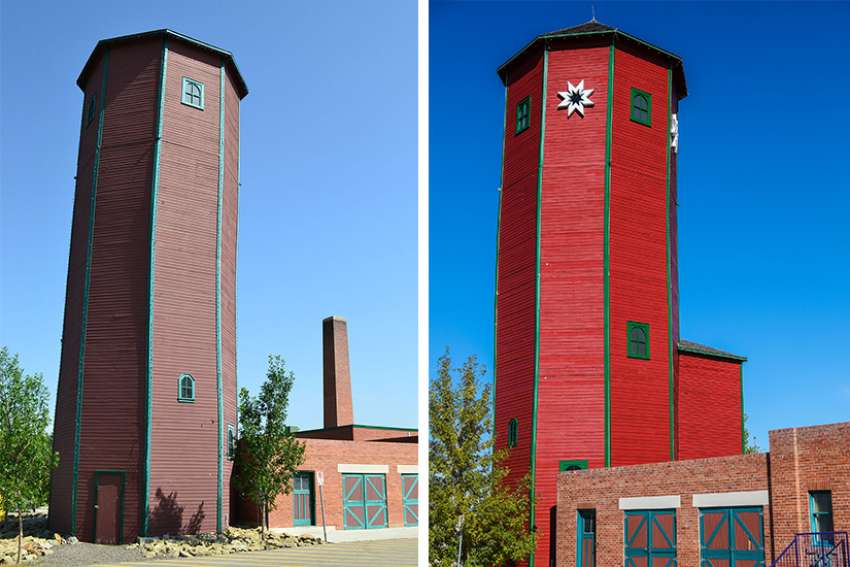As a wooden structure built when metal water towers were coming into prominence, the tower has fallen prey to wildlife, inclement weather and the simple reality of aging. It was stabilized and cleaned, and then, for decades, left to whither away. Recently, however, we were able first to repair its imposing 80-foot exterior and then to fully restore the glorious interior, creating the most remarkable boutique art gallery arguably in the country.
G.K. Chesterton once said, “Architecture is the alphabet of giants; it is the largest set of symbols ever made to meet the eyes of men.” He went on to say that a “tower stands up like a sort of simplified statue, of much more than heroic size.” And that is certainly true, in one sense, about this aged tower.
It stands as an exclamation mark upon the land, at the heart of the university, but it is not majestic in the usual sense. Even renovated and restored, it is slightly bowed, leaning slightly to one side, like an aged gentleman alone in a field. And while tall in stature, it is of humble origins.
In fact, in the archives of the Sisters of Providence we read tellingly that the tower was a godsend of sorts, under the protection of St. Joseph, its “King and Keeper.” But it was also, in reality, merely an elaborate plumbing mechanism, outdated even at the time it was built.
Perhaps because of this, the goal of renovating this structure was to celebrate its humble past, to preserve a unique structure at a time when so many heritage buildings are being given up to make way for newer developments. And as the team charged with its restoration gathered inside the tower, I commented that I felt an extraordinary sense of peace there.
It truly felt as though the cares of the world could not penetrate the walls. As soon as I said this I looked around sheepishly, fearful that I’d be labelled as a sentimentalist, but instead everyone was nodding. Our conservation architect spoke first.
“Have you ever heard of the Biophilia Hypothesis?” he asked. “It’s a well known theory that human beings need to be connected to the natural world.”
Like all academics, I immediately began to research the phenomenon. There is nothing more exciting than someone putting a concept around something long experienced but unnamed. And so it was with biophilia.
We are all familiar with understanding experience through phobias — the fear and aversion we have to myriad forces in our world. Less common is the tendency of seeing our world through philias — the positive energies and attractions that we might feel, as human beings, for the natural world. Biophilia speaks to this.
In its wider sense, of course, the hypothesis posits an understanding of our human connection with other flora and fauna. Just as fascinating to me is the concept of biophilia as it relates to conservation. Here the argument is that human beings will be more connected to restorations and developments that incorporate organic materials — what is often referenced as a major component of sustainable design and green architecture. Clinical evidence has actually shown that immunological and neuroendocrine systems actually improve in patients who are linked, in some way, to the natural world.
Is it a stretch, then, to feel this same energy in a building whose sole purpose was to supply water to a home for the aged and orphans, and whose remarkable natural timbers bear the marks of woodpeckers and mice? Is it crazy to think that the deep, rich smell of wood that suffuses the towering space is somehow healing and protective?
In Laudato Si’ Pope Francis reminds us that there is an “integral ecology” and an “inseparable bond” between concern for nature, justice for the poor, commitment to society and interior peace. He reminds us that our environment — and I would like to think our built environment as well — “is a complex system linked to many of the essential conditions for human life.”
Surely conservation is part of that remarkable equation — a direct opposite of what the Pope descries as our “throwaway” culture of consumerism — and the tower is a small, but powerful symbol of that connective tissue.
(Turcotte is president of St. Mary’s University in Calgary.)
The water tower at St. Mary’s University has been restored (right) to its former glory.
Photo by Sergei Bleski
Figure of speech: Restored water tower is an oasis of healing
By Gerry Turcotte, Guest ColumnistThanks to generous donors, St. Mary’s University in Calgary was recently able to complete the restoration of our nearly 100-year-old water tower. Built by the Sisters of Providence in 1921, the tower has stood over the Midnapore site for nearly a century, its fortunes waxing and waning — mostly waning — over time.
Tagged under:


